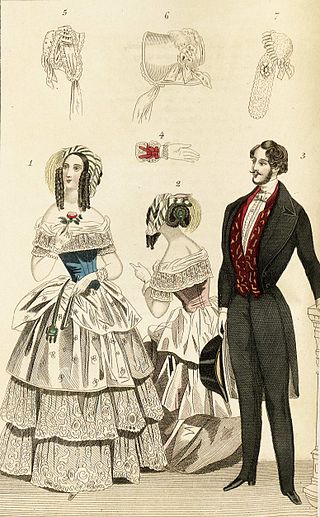
Victorian fashion consists of the various fashions and trends in British culture that emerged and developed in the United Kingdom and the British Empire throughout the Victorian era, roughly from the 1830s through the 1890s. The period saw many changes in fashion, including changes in styles, fashion technology and the methods of distribution. Various movement in architecture, literature, and the decorative and visual arts as well as a changing perception of gender roles also influenced fashion.
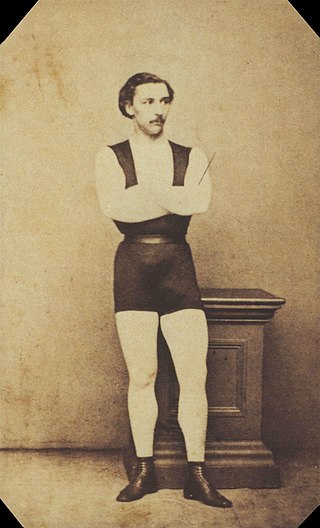
A leotard is a unisex skin-tight one-piece garment that covers the torso from the crotch to the shoulder. The garment was made famous by the French acrobatic performer Jules Léotard (1838–1870). There are sleeveless, short-sleeved, and long-sleeved leotards. A variation is the unitard, which also covers the legs. It provides a degree of modesty and style, while allowing for freedom of movement.

A sweater or pullover, also called a jersey or jumper, is a piece of clothing, typically with long sleeves, made of knitted or crocheted material that covers the upper part of the body. When sleeveless, the garment is often called a slipover, tank top, or sweater vest.

A shirt is a cloth garment for the upper body.
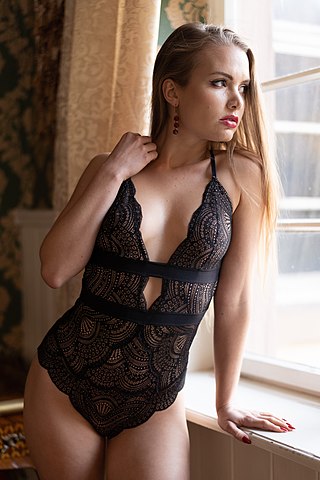
A bodysuit is a one-piece form-fitting or skin-tight garment that covers the torso and the crotch. The of a basic bodysuit is similar to a one-piece swimsuit and a leotard, though the materials may vary. Thong or T-front thong bodysuits usually have the crotch opening moved up to the front to underbelly area to increase the wearer's comfort. A bodysuit may have sleeves and varying shoulder strap and collar. Bodysuits can be made from a number of fabrics, including cotton, lace, nylon, etc. In general, textile bodysuits include expandable fiber such as spandex for a better fit to the shape of the body.

A blouse is a loose-fitting upper garment that may be worn by workmen, peasants, artists, women, and children. It is typically gathered at the waist or hips so that it hangs loosely ("blouses") over the wearer's body. Today, the word most commonly refers to a girl's or woman's dress shirt, although there is considerable confusion between a true blouse and a women's shirt. It can also refer to a man's shirt if it is a loose-fitting style, though it rarely is. Traditionally, the term has been used to refer to a shirt which blouses out or has an unmistakably feminine appearance, although even many "standard" shirts today have a somewhat blousy fit, and the numbers of men wearing such shirts may match that of women wearing actual blouses.

A babydoll is a short, sleeveless, loose-fitting nightgown or negligee, intended as nightwear for women. It sometimes has formed cups called a bralette for cleavage with an attached, loose-fitting skirt falling in length usually between the belly button and upper thigh. The garment is often trimmed with lace, ruffles, appliques, marabou, bows, and ribbons, optionally with spaghetti straps. Sometimes it is made of sheer or translucent fabric such as nylon or chiffon or silk.
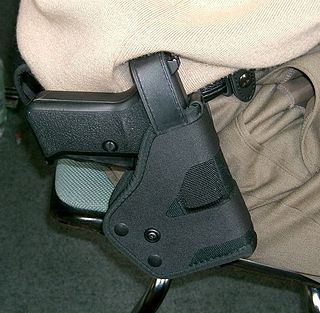
A handgun holster is a device used to hold or restrict the undesired movement of a handgun, most commonly in a location where it can be easily withdrawn for immediate use. Holsters are often attached to a belt or waistband, but they may be attached to other locations of the body. Holsters vary in the degree to which they secure or protect the firearm. Some holsters for law enforcement officers have a strap over the top of the holster to make the handgun less likely to fall out of the holster or harder for another person to grab the gun. Some holsters have a flap over the top to protect the gun from the elements.

A sleeveless shirt is a shirt that is manufactured without sleeves or with sleeves that have been cut off. Depending on the style, they can be worn as undershirts, by athletes in sports such as track and field and triathlon, or as casual wear by both men and women.

Fashion in the 1990s was defined by a return to minimalist fashion, in contrast to the more elaborate and flashy trends of the 1980s. One notable shift was the mainstream adoption of tattoos, body piercings aside from ear piercing and, to a much lesser extent, other forms of body modification such as branding.

1840s fashion in European and European-influenced clothing is characterized by a narrow, natural shoulder line following the exaggerated puffed sleeves of the later 1820s and 1830s. The narrower shoulder was accompanied by a lower waistline for both men and women.
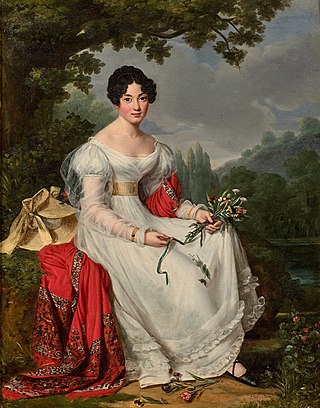
During the 1820s in European and European-influenced countries, fashionable women's clothing styles transitioned away from the classically influenced "Empire"/"Regency" styles of c. 1795–1820 and re-adopted elements that had been characteristic of most of the 18th century, such as full skirts and clearly visible corseting of the natural waist.

The neckline is the top edge of a garment that surrounds the neck, especially from the front view. Neckline also refers to the overall line between all the layers of clothing and the neck and shoulders of a person, ignoring the unseen undergarments.

Fashion in the 1970s was about individuality. In the early 1970s, Vogue proclaimed "There are no rules in the fashion game now" due to overproduction flooding the market with cheap synthetic clothing. Common items included mini skirts, bell-bottoms popularized by hippies, vintage clothing from the 1950s and earlier, and the androgynous glam rock and disco styles that introduced platform shoes, bright colors, glitter, and satin.
A cheerleading uniform is a standardized outfit worn by cheerleaders during games and other events. These uniforms typically include the official colors and mascots of the school or team and are designed to make the wearer appear physically attractive.

A back closure is a means for fastening a garment at the rear, such as with a zipper, hooks-and-eyes or buttons. Back closures were once common on Western female clothing, but have recently become less so, especially on female casual and business attire. They continue, however, to be widely used in underwear, formal wear and specialized clothing. Back closures are also common in garments for infants and toddlers.

The OG-107 was the basic work utility uniform (fatigues) of all branches of the United States Armed Forces from 1952 until its discontinuation in 1989. The designation came from the U.S. Army's coloring code "Olive Green 107", which was the shade of dark green used on the original cotton version of the uniform. The OG-107 was superseded by the Battle Dress Uniform (BDU) throughout the 1980s, and was also used by several other countries, including ones that received military aid from the United States.

A muffin top is a slang term typically used to describe a person's body fat that extends horizontally over the edges of the waistline of tightly fitting pants or skirts, visible when there is a gap between the upper and lower garment. The term is a reference to the way a muffin appears when it has been baked in a muffin tin, so that the top of the muffin extends horizontally over and around the top of the tin or casing.

Traditional clothing is one of the factors that has differentiated this nation from neighboring countries, dating back as far as the Illyrian era.

Fashion and clothing in the Philippines refers to the way the people of the Philippine society generally dress up at home, at work, travelling and during special occasions.


























